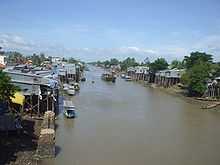Vĩnh Tế Canal
Coordinates: 10°34′12″N 104°55′34″E / 10.570°N 104.926°E

The Vĩnh Tế Canal (Vietnamese: Kênh Vĩnh Tế) is an 87-kilometre-long (54 mi) canal in southern Vietnam, designed to give the territory of Châu Đốc a direct access to the Hà Tiên sea gate, Gulf of Siam.[1][2]
After the construction of Thoai Ha Canal, Emperor Gia Long of Nguyễn Dynasty ordered the mandarin Nguyễn Văn Thoại to dig a new canal along the Cambodian–Vietnamese border.[1][2] The emperor's edict said: "Công trình đào sông này rất là khó khăn, nhưng kế giữ nước và cách biên phòng quan hệ chẳng nhỏ, chúng người tuy rằng ngày nay chịu khó, nhưng mà ích lợi cho muôn đời về sau..." (..this canal-digging project is tough, but its role in [our] national security and national defense is not small, we should accept the hardship so that our descendants would have the benefit ..).[2]
The construction of the canal was started in the end of 1819.[2] The project used about 80,000 local Vietnamese and Khmer workers.[2] After the death of Emperor Gia Long, the succeeding Emperor Minh Mạng continued the project. The workers, especially the Khmers, were heavily exploited by being forced to do hard work, which resulted thousands of deaths from fatigue and consequent disease during the canal's construction.[3] Consequently, the Vinh Te Canal became a symbol of Vietnamese mistreatment of the Khmer and was used later by the Khmer Rouge in anti-Vietnamese propaganda.[4] The construction was completed in 1824 and Emperor Minh Mạng named the canal after Châu Vĩnh Tế, the wife of its builder Nguyen Van Thoai.[2] From that point on, the canal plays an important role in the southern Vietnam's communication, transportation and the definition of the border of Vietnam and Cambodia.[1][5]
References
- ↑ 1.0 1.1 1.2 Writing staff (2006). "Kênh Vĩnh Tế". Encyclopedic Dictionary of Vietnam. Retrieved 2009-02-17.
- ↑ 2.0 2.1 2.2 2.3 2.4 2.5 Bảo Trị & Thành Trinh (2009). "Từ kênh Võ Văn Kiệt nhớ kênh Vĩnh Tế" (in Vietnamese). An Giang Newspaper. Retrieved 2009-02-17.
- ↑ Thi Dieu Nguyen (1999). The Mekong River and the struggle for Indochina: water, war, and peace. Greenwood Publishing Group. p. 19. ISBN 0-275-96137-0.
- ↑ Nayan Chanda (1986). Brother Enemy: the war after the war. Harcourt Brace Jovanovich. p. 52. ISBN 0-15-114420-6.
- ↑ Dodd, Jan; Lewis, Mark (2003). Rough guide to Vietnam. Rough Guides. p. 168. ISBN 1-84353-095-3.
| ||||||||||||||||||||||


